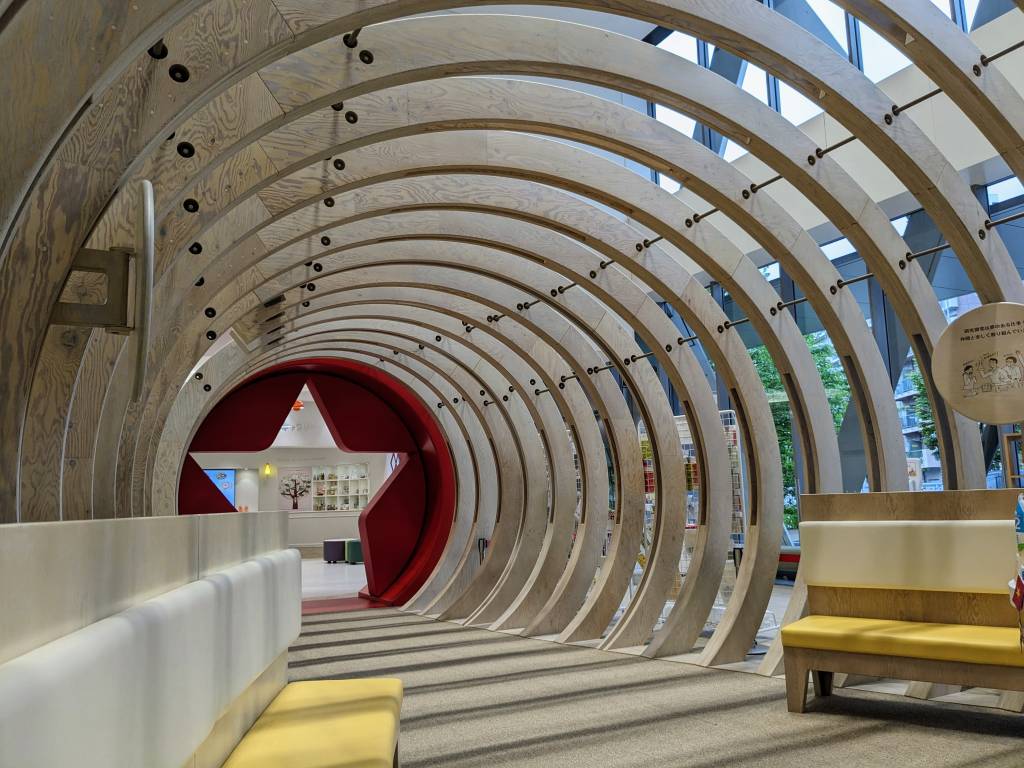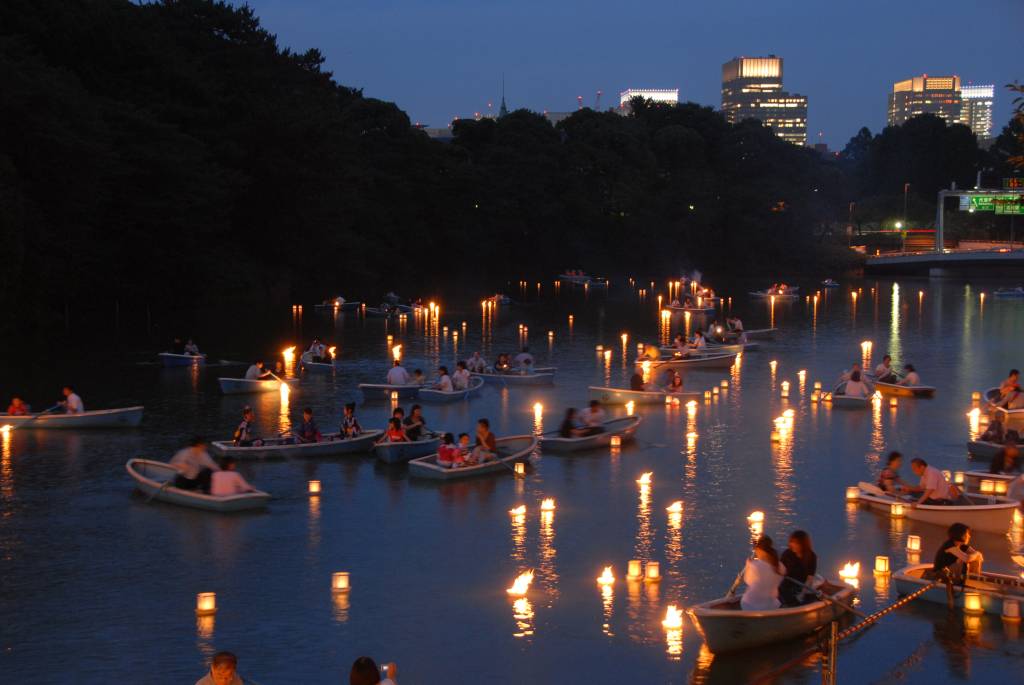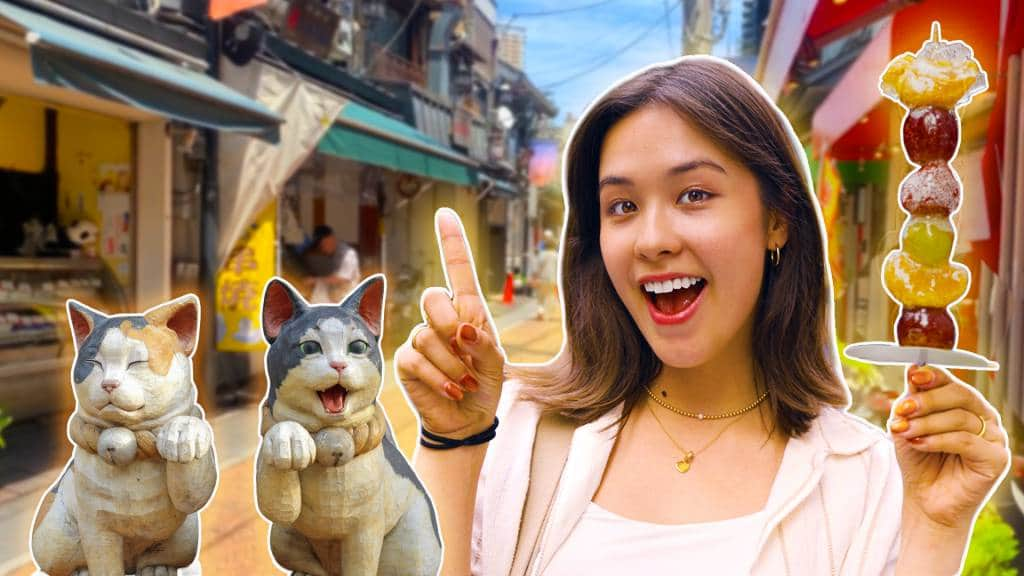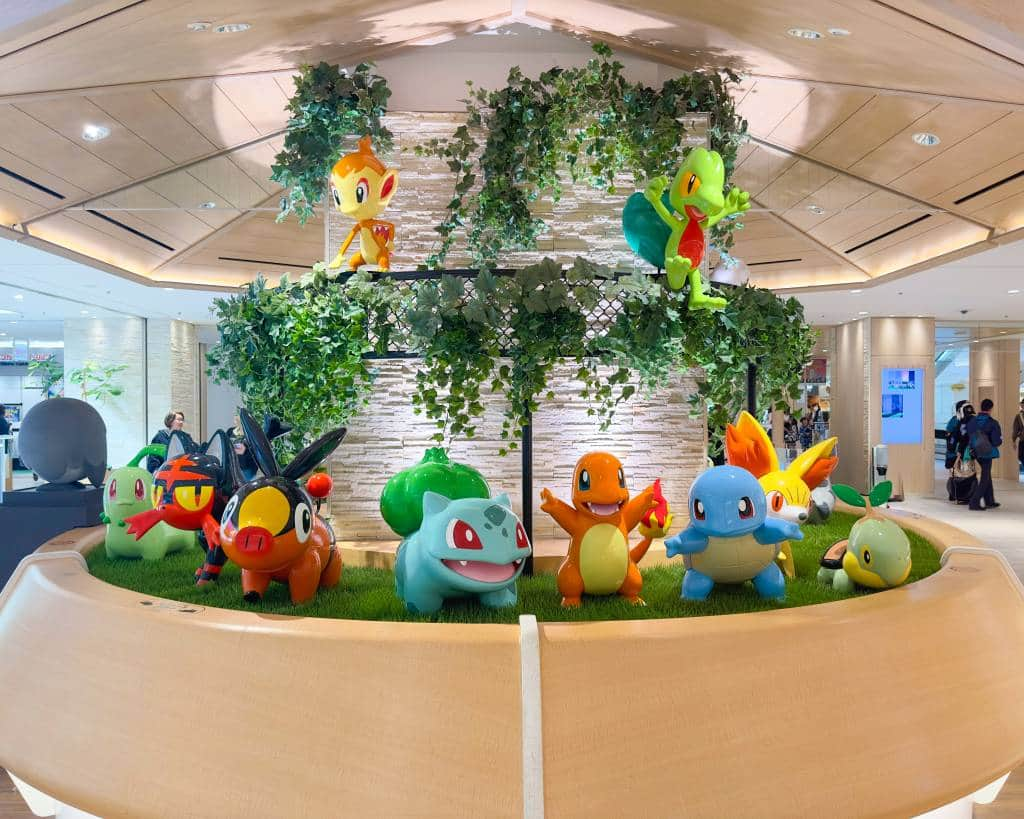Beneath the skyscrapers and behind the alleys, Shinjuku has a stunning park with traditional gardens, a tea house and some of that precious fresh air.
Offering a green refuge since the Edo-period, Shinjuku Gyoen has been the perfect place to escape the city rush for many a generation of Tokyoites (imperial or otherwise). Only 10-minutes from Shinjuku Station, it has English and French gardens, a traditional Japanese garden and plenty of wide, open green spaces to enjoy. During spring, over 1,000 cherry trees bloom and the park is a popular spot for hanami, while the greenhouse offers a warmer refuge in the colder months. If you’re looking to stroll, picnic or read a book then head on over to the city’s favorite park.

The park’s history
After receiving the land as a gift from the shogun, feudal lord Naito created a garden in 1772, although it has changed dramatically since then. During the changes of the Meiji Restoration, it became a an experimental agricultural center, then a botanical garden before being designated as an imperial garden and used for entertaining guests to the city.
Unfortunately, the final design of 1906 was lost in the air-raids of WWII, and the garden was re-built afterwards. The park was opened to the public in 1949 and has been a favorite ever since. The official name of the park still includes Gyoen, which means “imperial garden” in Japanese—a nod to its former role.
Shinjuku Gyoen: A walkthrough
At just under 60 hectares, the park is no backyard and is home to three distinct gardens with additional forests, ponds, lawns and a greenhouse, among other highlights. Oval-shaped with three entrances, you can easily spend an afternoon wandering through the greenery, with traditional buildings and ancient trees dotted throughout.
The three gates
The garden has three entrances, spaced out to allow access at different points and with different train stations nearby. The main entrance is the Shinjuku Gate (a 10-minute walk from Shinjuku station, 5 minutes from Shinjuku Gyoen-mae Station), which leads you towards the top of the Japanese Garden via the west resthouse. The Okido Gate (5 minutes from Shinjuku Gyoen-mae Station) is right next to the greenhouse and Tamamo Pond. Finally, the Sendagaya Gate (5 minutes from Sendagaya Station) is close to the cherry-tree area and Maple Hill and leads you between the Japanese Garden and the French Garden.

The three gardens
The park has a traditional Japanese Garden, an English Landscape Garden and a French Formal Garden—the latter two being the most respected Western gardens in the Meiji era. Unfortunately, the English offering is not that exciting; it’s a large, open space bordered with cherry trees, and unless you’re a landscaper (or visiting in spring), probably the least interesting of the three. Designed to move away from rigid French garden design, it offers an idealized view of nature, similar to a pastoral landscape, which is definitely in harmony with Japan’s garden style, but is a bit boring to actually look at. Moving swiftly on, the French option is more eye-catching, with symmetrical designs and beautiful rosebeds.
The most popular and oldest of the gardens though, is the traditional Japanese garden. With a series of linked ponds, teahouses and the Taiwan Pavilion, it’s a beautiful example of traditional design and features mature trees, perfectly maintained. Built for the wedding of the Showa Emperor, the pavilion is called the Kyu Goryotei in Japanese, its impressive design is a real highlight. The tea rooms offer a chance to try some high-quality green tea and seasonal wagashi (sweets) as you enjoy the view.

Bonus areas: forests, ponds and greenhouses
Spread throughout the garden you’ll find plenty of other smaller areas which aren’t included in the three main gardens. One of the largest is the Mother and Child’s Forest (towards the Shinjuku side) which offers shady paths and space to wander. Down towards the Sendagaya Gate you’ll find Maple Hill (great in autumn), and a cherry tree area for spring. There is also a chrysanthemum growing area, but this is not open to the public.

The Tamamo Pond is a beautiful algae pond and is usually quieter than most areas in the garden while the middle, lower and upper ponds are more picturesque. The greenhouse is home to beautiful tropical and sub-tropical plants and is a welcome respite in colder months—located on the edge of the grounds close to the Okido Gate.
Seasonal highlights
Whenever you arrive in the gardens (even winter!) there’s plenty to see, with seasonal changes being the mainstay of Japanese garden design. If you somehow haven’t heard about Japan having four seasons, let it be shown to you in garden form—through camellias, cherry blossom, hydrangeas and more.

Spring (March to May)
If you’re looking for some flowers to admire, then cherry blossom is a pretty easy place to start. The area between the Shinjuku Gate and the greenhouse has plenty of stunning trees (bordering the English Garden) and you’ll find some dotted around the Japanese Garden too. If you head right after entering through the Sendagaya Gate, you’ll find another group of trees with some by the lower pond as well. There are around 12 varieties and over 1,000 trees, meaning you can visit pretty much anytime in the season and see at least some blossoms. As most trees are of the somei yoshino variety, late March to early April is the busiest time for hanami parties.
The camellia are also in bloom during early spring as the park has over 40 different varieties to admire, with different ones blooming throughout spring, autumn and winter. There will be beautiful wisteria in place near the Taiwanese Pagoda in April to May which is small but pretty.
Summer (June to August)
From June to July, aka rainy season, the hydrangeas appear—one of the top seasonal indicators of the year. Around the same time, the roses of the French Garden bloom beautifully, with the withering heat not quite kicking in yet (thank goodness). After that, things tend to just be green and hot, so we suggest you find some shade to relax under!

Autumn (September to November)
The main event of autumn at the park is the annual chrysanthemum show which takes place from November 1st to 15th each year. While the park has been growing the flowers since 1904 and holding the festival since 1929, it actually uses flowers from Akasaka for the displays. As the imperial flower, the chrysanthemums are grown with extraordinary care and displayed in impressive shapes during the event.
The park will also have autumn leaves of course, especially in the Japanese Garden and in Maple Hill (unsurprisingly), close to Sendagaya Gate. Different trees are dotted throughout the gardens—with ginkgo, sycamore and cherry trees turning a lovely hue. It isn’t really one of the top spots in the city, unfortunately (you can’t have everything, Shinjuku Gyoen) but it’s still pretty good.
There are also more camellias to view, especially the sasanqua variety, which is the variety native to Japan. Over in the French Garden the roses are blooming again, this time with smaller buds but deeper in color and with a stronger scent.

Winter (December to February)
Winter is a sparse month for gardens everywhere, but at least here you can see some impressive camellias (camellia hiemalis if you were wondering). Since it’ll be more than a little chilly, make the most of the greenhouse and enjoy the warmer rooms, or use the clear blue skies for some beautiful photos. Keep an eye out for yukizuri, snow protectors placed on certain pines and other trees during snow season.
Access
The park’s three entrances can be reached easily from train and metro stops. While Shinjuku Station is a 10-minute walk from the Shinjuku Gate, Shinjuku-Gyoenmae Station on the Marunouchi Line is 5 minutes closer, as well as being five minutes from the Okido Gate. The Sendagaya Gate is a short walk from Sendagaya Station, which is on the Chuo Line. Nearby stations like Yoyogi (Chuo, Oedo, Yamanote) and Kokuritsu-Kyogijo (Oedo Line) are also options.
Entry fees and opening hours
It costs ¥500 for adults to enter the park, and half off for seniors and students. You can purchase tickets at the machines near the gates or from an attendant in the booth.
From March 15 to June 30 and August 21 to September 30, the garden is open from 9 am to 5:30 pm (gates close at 6 pm).
From October 1 to March 14, the garden is open from 9 am to 4 pm (gates glose at 4:30 pm)
During the warmer months July 1 to August 20, the garden is open a little later from 9 am to 6:30 pm (gates close at 7 pm).
It’s closed on Mondays and over the new year period (Dec 29 to Jan 3). During cherry blossom season (March 25–April 24) and the Chrysanthemum Festival (Nov 1–15) it remains open on Mondays too.
Restaurants

If you get peckish near the park then Shinjuku’s incredible range of restaurants is only a stone’s throw away. Spots like Ain Soph Ripple, Tokyo Mentsudan and Tempura Tsunahachi Rin are all up for grabs. If you don’t fancy walking right back into the hustle and bustle though, there are some great options nearby.
For some of the best curry in town, Curry Kusamakura offers bowls of varying spice levels with delicious toppings like their popular grilled eggplant. They have a vegetarian option as well as a chicken curry—look for the yellow signs!
If you’re looking for a halal and/or vegan friendly spot, then Ouka has you covered. Serving up delicious bowls of ramen and wagyu beef with changing specials, the small counter restaurant is a friendly spot for lunch or dinner.
Places to stay
If you’re keen to stay closer to the park than the middle of Shinjuku, there are plenty of options to choose from. We’ve picked our top hotel, hostel and capsule options below!
Apartment Hotel Shinjuku | From ¥6,800 per night
Like a hotel in a house, this place is sort of like renting a tiny apartment with a reception desk. You get a room with a small kitchenette and a more local feel than one of the many highrises. The four rooms have different themes, mainly modern or retro, and you get a private bathroom, wifi and the ability to cook some simple meals—what’s not to love? Check rates and availability.
Hostel Pumpkey Tokyo | From ¥2,700 per night
A basic but friendly hostel, Pumpkey offers female-only dorms, mixed dorms and group rooms too. The lowest prices are for dorms, but the private rooms work out fairly cheap too, although you are sharing a bathroom. Check rates and availability.
Shinjuku Kuyakusho-mae Capsule Hotel | From ¥3,500 per night
Offering male and female capsules (not all do), this place is a smart and affordable way to get a little more privacy than a regular hostel dorm. It has a weirdly impressive Greco-Roman–style bath area, free wifi and a bar/lounge area to relax and eat in. Check rates and availability.
Since guys rooms often sell out faster, here is an alternative option (male-only) nearby.

Events at Shinjuku Gyoen
The two most popular events in the park are (of course) seasonal celebrations, and while you’ll no doubt be able to guess the first, the second might not be quite so obvious.
Cherry blossoms | Late March to late April
Spring is of course cherry blossom season, and the park is home to 1,500 cherry trees which bloom fantastically for around a month from late March. Thanks to the mix of varieties, the bloom covers a longer stretch than most places, and the open spaces of the park mean that the crowds never feel too intense.
Chrysanthemum Festival | Early November
Cultivated in the gardens since 1904, chrysanthemums have a special place in the park’s history. The festival has been running since 1929 and uses flowers from the Akasaka Villa grounds rather than those from the actual gardens, as is the tradition. Huge flower beds are displayed with impressive displays—you’ll never look at a chrysanthemum in the same way again.
| At the door: ¥500 | ||
| At the door: ¥250 | ||
FAQs
What is there to do in Shinjuku Gyoen?
In the park you can admire the traditional Japanese, French and English gardens as well as strolling through refreshingly open spaces. There are small cafes as well as a Japanese tea room, and it’s an ideal place for a picnic. The park is popular for hanami parties during cherry blossom season and is a great place to relax when you need an escape from the city streets.
How do you get to Shinjuku Gyoen
Shinjuku Gyoen is easily reached from Shinjuku Station—around a 10-minute walk—or from Shinjuku-Gyoenmae which is a five-minute walk. You can also head to Sendagaya or Kokuritsu-Kyogijo stations to access the park from the Sendagaya Gate.
What time does Shinjuku Gyoen open?
Shinjuku Gyoen opens at 9 am year round. Closing times vary depending on the season.
- From March 15 to June 30 and August 21 to September 30, the garden closes at 6 pm
- From October 1 to March 14, the garden closes at 4:30 pm
- From July 1 to August 20, the garden closes at 7 pm
The park is closed on Mondays and a few days around New Year’s, but remains open throughout cherry-blossom season and the Chrysanthemum Festival.
Where to eat near Shinjuku Gyoen?
Since the park is so close to Shinjuku Station, you won’t be short of places to eat. Right by the park however, you’ll find the local haunt of Curry Kusamakura—a fantastic curry spot with eggplant grilled to perfection (and a vegetarian option too). Hamburg Will is a place for a fancy Japanese take on the hamburger, while Halal Ramen Ouka offers a halal-friendly option for ramen. Check out the Restaurants section of this post for more options.
Get our Tokyo Cheapo Hacks direct to your inbox
-
 Tokyo’s Best Apartment-Style Hotels, by Area
Tokyo’s Best Apartment-Style Hotels, by Area -
 Highway to Hot Springs: Tokyo to Kusatsu Onsen by Bus
Highway to Hot Springs: Tokyo to Kusatsu Onsen by Bus -
 The Best Pocket Wi-Fi for Visiting Japan — Compared
The Best Pocket Wi-Fi for Visiting Japan — Compared -
 Go-Karting in Tokyo: Everything You Need To Know
Go-Karting in Tokyo: Everything You Need To Know -
 Morning Sumo Practice in Tokyo—Everything You Need To Know
Morning Sumo Practice in Tokyo—Everything You Need To Know -
 First-Time Harajuku Itinerary: Fashion, Street Food, and More
First-Time Harajuku Itinerary: Fashion, Street Food, and More
Recommended hotels located nearby
-
Shinjuku 0.7 km
-
Kabukichō, Shinjuku 0.7 km
-
Shinjuku 0.4 km
-
Shinjuku 0.8 km




























